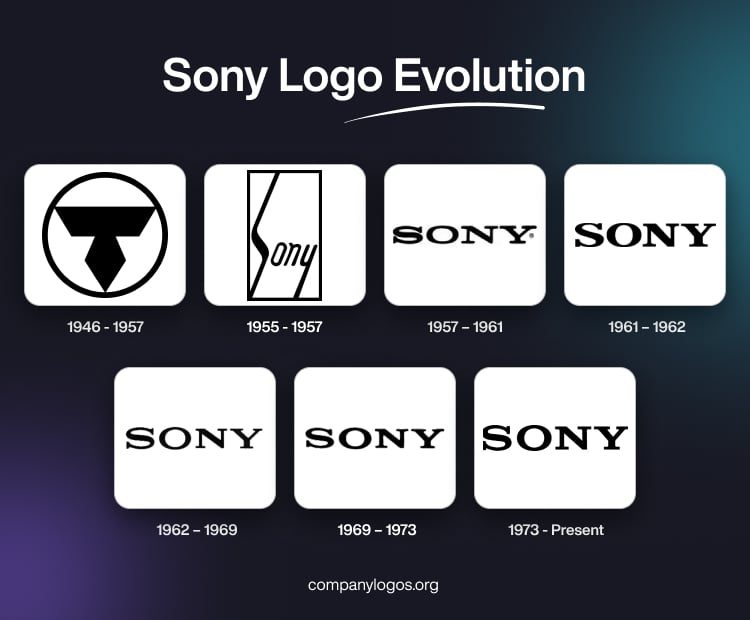
Sony Corporation is a renowned Japanese multinational company that operates in various sectors, such as electronics, gaming, entertainment, and financial services. The Sony logo has undergone a remarkable transformation over the years and reflects the company’s growth and evolution. The article traces the evolution of the Sony logo and the history behind the company, among other details.
The Genesis of the Sony Logo (1946 – 1957)
The first logo of the company featured a monochrome roundel with an abstract geometric figure inside. Drawn in black, the geometric figure, set against a white background, was created in the form of a trapezoid with its base up, while a rhombus was connected to its bottom part, the bottom end of which touched the thick edge of the roundel.

(1955 – 1957)
In 1955, the company changed its name to Sony Corporation. The new Sony logo featured a stylized “S” symbol, which was inspired by the visual representation of the letter “S” in an electromagnetic wave form. It featured a stylized wordmark with a distinct typeface and a unique design element. This emblem used to be prominently featured on Sony’s products and marketing materials, which helped it create a strong brand identity. The logo had elongated italic letters “S” and “y” placed in a rectangular frame.

(1957 – 1961)
In 1957, Sony updated the typography of its logo by opting for a more modern and streamlined look. As the company expanded globally, the logo was changed by removing the rectangular frame and using the inscription “Sony” in a bold serif font. Also, by consistently using the Sony logo across international markets, the brand became recognised globally.

(1961 – 1962)
The logo was further improved by making the letter “S” little bigger than the rest. The other iterations of the logo differed in the use of altered font and bold letters.

(1962 – 1969)
In this logo iteration, the design was made sharper and the serifs of the wordmark were straightened. The contours of the letters were made a little thinner, which added the quality of timeless elegance to the logo. The monochrome colour of the logo was retained for continuity.

(1969 – 1973)
In the 1969 logo iteration, the serifs of the letters of the wordmark were rounded at the corners. This wordmark looked more balanced when compared to the previous ones, and it exuded a sense of confidence and professionalism.

(1973 – Present)
With the advent of the internet, Sony simplified its logo to get better visibility and adaptability. The logo was seamlessly integrated into Sony’s multimedia and online presence, thereby ensuring brand consistency across various channels. In recent years, subtle updates have been made to the logo to refine its design. At the same time, the essence of the brand has been preserved. In 1973, Norio Ohga, the CEO, was satisfied with the iteration of the logo. Using the font Clarendon with slight modifications, the logo used black on a white background to symbolise elegance and integrity.

The Elements of the Sony Logo
Symbol
The current version of the Sony logo features a straightforward logotype that was introduced in 1959. According to branding experts, this logotype conveys simplicity and resilience and has seen minor adjustments over time. This was done primarily under the guidance of the former Sony president and chairman, Norio Ohga. Besides, these refinements were predominantly overseen by Sony’s chief of design, Akio Morita, and designer Yasuo Kuroki. In 2009, Sony adopted its current slogan, “Make Believe.”
Font
Sony’s logo uses a slightly customised version of the Clarendon font.
Colour
The Sony logo is black in colour, which represents attributes such as integrity, excellence, sophistication, and the brand’s rich heritage.
The History of Sony
Sony came into existence in the aftermath of the Second World War in Tokyo, Japan. In 1946, Akio Morita and Masaru Ibuka established Tokyo Telecommunications Engineering Corporation with a modest capital of just over $1,500. The company commenced its operations with research activities and, within a year, launched its first product, a power megaphone. By 1950, it had introduced Japan’s first tape recorder.
Today, Sony Corporation is a globally renowned multinational conglomerate with headquarters in Tokyo. It has diverse business interests spanning segments such as industrial and consumer electronics, entertainment, gaming, and financial services. Sony also boasts of being the world’s largest music entertainment business, the biggest gaming console business, and one of the largest gaming publishing operations. Additionally, it is a major manufacturer of electronics for consumer markets and is a significant force in the TV and film entertainment industry segments.
During the 1960s, 1970s, and 1980s, Sony played a crucial role in Japan’s rise as a major exporter. It significantly enhanced the appeal of Japanese products in the American market. Importantly, Sony has always demanded premium prices for its consumer electronic goods and has consistently resisted the temptation to lower prices. In 1971, the co-founder of Sony, Akio Morita, succeeded fellow co-founder Masaru Ibuka as the president of the company. The global recession of the early 1980s saw sales plummet for Sony. As a result, the company was forced to slash the prices of its products, which resulted in a dramatic drop in profits. During this period, some analysts even predicted Sony’s demise. It was at this juncture that Norio Ohga assumed the role of the company’s president.
Ohga expanded the footprint of the company by creating the CD in the 1970s and 1980s and the PlayStation at the start of the 1990s. In 1988, he acquired CBS Records, followed by Columbia Pictures a year later. Inspired by the vision of Akio Morita and his successors, Sony aggressively diversified into new ventures. It was driven by the quest for “convergence”, which was about connecting digital electronics, film, and music through the internet. However, this expansion proved unprofitable and threatened Sony’s ability to command higher prices for its products.
Sony has an excellent track record of introducing new technologies. For instance, in 1955, the company launched Japan’s first transistor radio, the TR-55, followed shortly by a mobile transistor radio. In 1960, Sony introduced the world’s first direct-view mobile TV, the TV8-301. Two years later, the company manufactured the smallest all-transistor TV. Sony also launched the Handycam, an 8mm portable camcorder, and in 2003, released the world’s first Blu-ray disc player. In 2005, Sony updated the Handycam and created the smallest video camera in the world, known as the High Definition Handycam.
Arguably the most influential product in Sony’s stable has been the Walkman, which was first launched in 1979. This tiny, lightweight, and pocket-size tape player revolutionised the way people listened to music. It transformed listening to music from a shared experience to a personal one. In 1984, Sony built on this success by releasing its first pocket-size CD player, the Discman. While the company’s dominance was reduced with CDs and tapes being phased out in favour of digital music, the influence of Walkman is still evident in today’s mobile devices.
Sony is also an influential player in the film and music industries through its Sony Pictures Entertainment and Sony Music divisions. In 1989, Sony acquired Columbia Studios, including its movie catalogue rights. This acquisition instantly established Sony Pictures as a success in the industry. These two divisions symbolise more than just Sony’s diversification; they form part of a calculated corporate strategy. So, by controlling its own content, Sony ensured its technological innovations were never hindered by a lack of industry support. This was seen in the success of Blu-ray over its competitor’s HD-DVD player.
In the video game segment, rivals Sega and Nintendo revived the gaming console industry at the end of the 1980s. And by recognizing the need for a new competitor with superior technical expertise and deep pockets, Sony created a new division called Computer Entertainment in 1993. Its PlayStation range of gaming consoles and mobile variants have since become reliable revenue generators for the company.
Interesting Facts About Sony
- Sony was founded in 1946 by two engineers, Masaru Ibuka and Akio Morita, under the name Tokyo Tsushin Kogyo (TTK). The company changed its name to Sony in 1958, a name that was derived from the Latin word “sonus” meaning sound. It was chosen so as it was found easier to pronounce internationally.
- The very first product Sony made was an electric rice cooker, which was a commercial failure. It sold less than 100 units due to poor cooking performance. Despite this rocky start, Sony diversified and innovated, which led to its rise as a global giant.
- Sony introduced the first Japanese-designed tape recorder in 1950 and licensed the transistor technology from Bell Labs in the early 1950s, which led to their breakthrough product: the pocket-sized TR-63 transistor radio in 1957. This radio gained international acclaim and helped establish Sony’s brand worldwide.
- Sony has been a pioneer in consumer electronics with landmark products such as the Trinitron colour TV, the Walkman portable cassette player launched in 1979, and the first compact disc (CD) player in 1982, which it developed in partnership with Philips.
- The Walkman was initially met with scepticism by Sony engineers, but Akio Morita insisted on its development. He famously stated that he would resign if it failed. The Walkman became an international sensation and sold hundreds of millions of units.
- Sony has a strong presence in imaging and sensing technology, and holds over 95,000 patents with 78% active. It is the world’s largest manufacturer of CMOS image sensors, which are widely used in cameras, smartphones, drones, and automotive applications.
- Sony once produced a special Walkman model for prison inmates with a transparent case to prevent hiding contraband inside the device.
- In 1998, Sony released a camcorder with night vision that controversially could see through dark clothes using infrared light. It led to a recall after selling nearly 700,000 units.
- Sony’s employee uniforms are designed by renowned Japanese fashion designer Issey Miyake, who is known for designing technology-driven clothing and Steve Jobs’ signature black turtlenecks.
- Sony has diversified beyond electronics into entertainment. It acquired Columbia Records and Columbia Pictures, and is also a major player in the video game industry with its PlayStation consoles.
- The company has been in the market for over 77 years and currently employs around 108,900 people with revenues close to $90 billion.
Finally
The Sony logo has evolved significantly over the years and reflects the company’s journey from a small electronics manufacturer to a global powerhouse. Throughout its transformations, the Sony logo has remained a powerful symbol. It represents the brand’s commitment to innovation, quality, and design excellence.